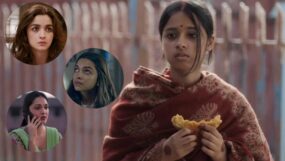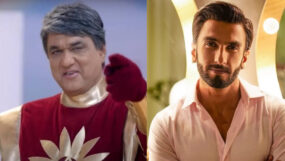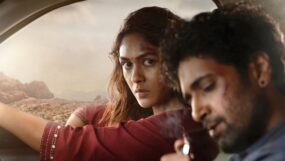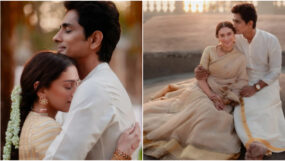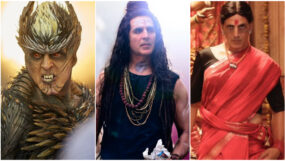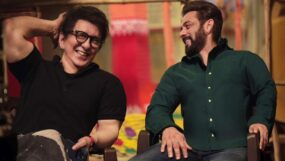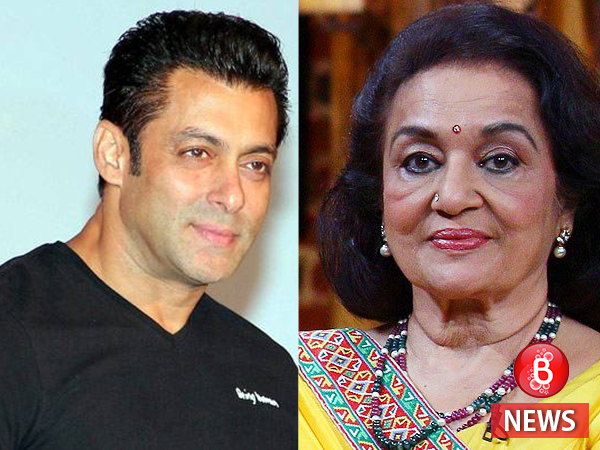
A new trend of celebrities coming up with their autobiographies is setting in, and legendary actress Asha Parekh, too has joined the league. She is ready to launch her own autobiography, titled ‘The Hit Girl’. What’s more interesting is that Salman Khan is the chosen one to launch this book. As a cherry on the cake, Salman has now penned the foreword of this book too.
With some kind words to say about Asha Parekh, Salman has revisited the golden era of Hindi Cinema, when innocence made for the essence of Bollywood films.
Read the foreword below. It’s truly come from heart.
“They don’t make them like her any more. Perhaps that is stating the obvious but my generation and the later ones have missed out on the great era of our movies when stories of innocence and grace ruled the screen, when boy-met-girl stories were wonderful, feel-good entertainers. No compromises, no need for self-publicity 24×7, no catering to a single screen or a multiplex audience. In fact Asha Parekh, Ashaji, represented the swinging era of the 1960s. An all-rounder, she was especially good at dance numbers, had a flair for comedy, emoted simply and effortlessly. Even if situations in the screenplay were incredible, she made them credible by never going over the top. She was the darling not only of the audience but also of film producers and directors who would rush to sign her on for a movie since she guaranteed box-office success.
My dad, Salim Khan, remembers that a film would be snapped up by the distributors and exhibitors if Ashaji was the heroine. Newcomers as well as the leading music directors of the time would be inspired to compose some of their best songs for her. She did justice to the songs by performing them with amazing ease, whether the number was purely Indian or westernised in its rhythm. Thanks to re-runs of her movies at cinema halls and on television channels as well as prints available on DVDs, it has been possible for someone like me to become familiar with the Asha Parekh magic. Right from her first film as a heroine, ‘Dil Deke Dekho’ to scores of blockbusters—my favourites are ‘Jab Pyar Kisise Hota Hai’, ‘Teesri Manzil’, ‘Mera Gaon Mera Desh’, ‘Kati Patang’ and ‘Caravan’—she had tremendous screen chemistry, particularly with her leading men Shammi Kapoor, Dev Anand and Rajesh Khanna.
The 1960s, the decade which defined her peak period, were notable for plots about the conflict between the wealthy and the poor. She would often portray a sweet-natured girl who falls in love with a boy who may not have been fortunate enough to have much money in his pocket but his heart would be richer than any king’s treasury. The prejudiced elders of her family and the villain with dishonourable intentions would be defeated in the end, proving there is nothing more important than to fall in love and preserve this connection for the rest of one’s life.
Today love can be on a short fuse. There can be a power breakdown or a separation of ways in a film’s strings of sequels or what are called a ‘franchise’. The hero or the heroine can change in the next edition of a franchise. Happy endings, the kind which were ordained for Ashaji and her heroes are not possible any longer. It all depends on which hero or heroine is marketable when a sequel is launched. Ashaji did not have to face such commercial necessities.
What if a ‘Kati Patang 2’ was ever conceived? What if Rajesh Khanna or Ashaji were shown to be having differences? What if either of them was substituted by another star? Would the sequel match the romantic appeal of the original?
These are just random thoughts. I am no expert at film analysis. But I can certainly say that we have to admire and respect our artistes who continue to serve as inspirations nowadays in various aspects like style, fashion and the professional approach towards performing before the camera.
During the ’60s ‘method acting’ was largely unknown. Neither did artistes learn the principles of acting in schools under the instruction of professors. Rather they were known to learn and evolve on the job. They were also known to be punctual and slipped into the skin of their characters—not by discussions and exercises at heavy-duty workshops. On their own steam they made the audience identify with the characters created for them by the writers and directors.
Ashaji relied as much on her instincts as on the instructions of her directors. When it came to dances, she was in harmony with the choreographers. Since she had started out as a child star, she did not have to struggle before the camera. An artiste can become selfconscious. It is not easy to be natural in one’s hand movements,
body language and the use of one’s voice and eyes. Technically she was at home leading to a pleasant, friendly screen presence. A bond was struck with the audience, a bond whereby she could compel them to share her laughter and tears.For a good artiste it is a must to be a good human being. In this context Ashaji’s kindness and concern for people in need continues to be a noteworthy example. She has been running a charitable hospital since decades. Which other artiste has done that in Mumbai, a city which is all about I-Me-Myself ? It could not be a smooth task for her to keep the institution running and helping out those who do not have sufficient resources for medical treatment.
In addition, over time she has been in the forefront of film associations dedicated to the welfare of artistes and technicians. When in need Ashaji has been a friend indeed to film workers and artistes facing rough weather, and that too without ever wanting recognition and praise for her silent service. I would take this
opportunity to salute Ashaji for standing by firmly with the film industry where fortunes can change drastically, a film industry which is associated by the public unfortunately only with glamour.Sometimes one wonders why Ashaji opted out of the movies prematurely. Maybe she was not satisfied with the roles offered to her of the clichéd mother figure who has to suffer and shed tears. Maybe she did not want to be a part of a system averse to writing strong roles for senior women artistes. Maybe she wished to quit at a point when there were no new challenges for her as an artiste. Whatever the specific reason may be, we have had to accept her decision to stay away from the studios. The decision could not have been an easy one to take but she has, depriving me of the chance to be with her in the same frame.
All of us Khans have been blessed. Ashaji has been a family friend. We may not see her regularly but we know she is there for us, and we are there for her, just a phone call away. She joins us for our festive celebrations for the Ganpati puja, Christmas and Eid. She has treated my brothers Arbaaz and Sohail, and sisters Alvira and Arpita, like kids. She has watched us grow up. She has never been judgemental, she has been a part of our high phases and low.
To be honest I was not at all sure if I could do justice to her many achievements in a foreword. This is the first foreword I have ever attempted. To my surprise my words flowed easily. Hopefully I have been able to express at least a fraction of my affection and regard for Ashaji, for her smiles and laughter and above all for her compassion for cinema, and the agonies and ecstasies she has faced in her life.
Needless to say this autobiography by Ashaji was much needed. The Hit Girl has taken us through her journey belatedly. It was about time.
‘Achha Toh Hum Chalte Hain…’ went the lyrics of one of her songs. She can never say goodbye really. Because movie stars may come and go but Asha Parekh will remain in our hearts forever.
– Salman Khan”
We look forward to ‘The Hit Girl’.
A strongly opinionated, free-spirited, budding Bollywood journalist, she likes to write anything in her own quirky style. When not running around to get assigned tasks completed, you will find her either painting, indulging in photography or dreaming in the la la land.


